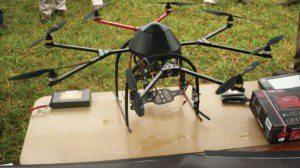
The UAS above was operated by Virginia Tech and University of Florida researchers to map a soybean field in southeast Virginia.
Interest is growing rapidly in the use of unmanned aircraft systems (UASs) for precision agriculture, which potentially could become the largest application for this developing technology.
Most of the practical applications of UASs so far have occurred in Europe and in countries like Canada, Australia and Japan where there are fewer airspace regulations compared with the United States. UAS use for commercial purposes is prohibited in the United States; only hobbyists are allowed to fly small, radio-controlled airplanes for recreational purposes. Currently, there are two broad platforms for UASs: the fixed-wing and rotary-wing (copter) types.
Fixed-wing UASs have the advantage of being able to fly at high speeds for long durations with simpler aerodynamic features. Some of them don't even require a runway or launcher for takeoff and landing.
Rotary-wing UASs have the advantage of being able to take off and land vertically and hover over a target. However, because of mechanical complexity and shortened battery power, they have a short flight range. Cameras gather images with normal light, infrared or thermal, still photos or video formats. These images are digitized, georeferenced and mapped.
Crop consultants and farmers can use this information to scout crops, detect nutrient deficiencies, assess flood or drought damage, forecast weather patterns, monitor wildlife and even locate cattle in distant pastures. Research also reveals that UASs can be used for detecting atmospheric microbes and air pollution. Spot-spraying chemicals and micronutrients is another use.
Image courtesy of Southeast Farm Press.

